
|
MAIN MENU |
ABOUT CAMBODIA |
RECOMMENDATION |
PHOTO GALLERY |
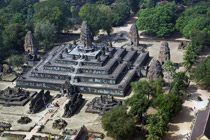
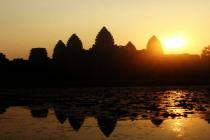
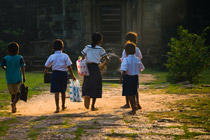
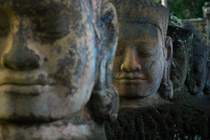
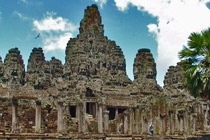
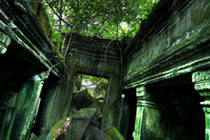
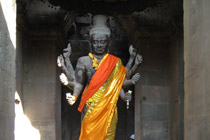
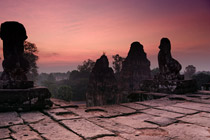
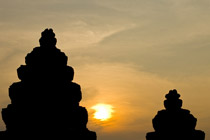
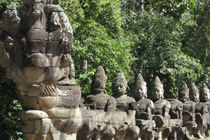
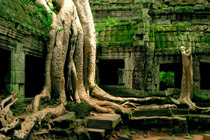
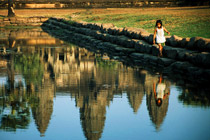
|
Package Tour
ONE DAY VISIT
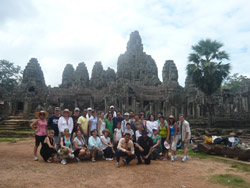 Morning tour:
Morning tour:
Visit Angkor Thom comprised of the Bayon Temple, Baphoun, Elephant Terrace and The Terrace of the Leper King.
Enter the city of Angkor Thom through the monumental south gate, Avenue of gods and asuras lining the bridge across the moat.
Bayon temple or state temple of Javavarman 7 is one of the most enigmatic and powerful religious constructions in the world. It is a unique mass of “face tower” which creat a stone mountain of ascending peaks. There were originally 54 towers of which is 37 are still standing today. Most are carved with four faces on each cardinal point. The central has many more.
Baphoun is the vast temple near the center of Angkor Thom. It’s under France’s restoration project, it is possible to access the entrance gate and the elevated walkway entrance and there is a huge reclining Buddha on the west side of the temple.
Elephant Terrace is the heart of Angkor Thom and looks out over the Royal Square. It marks the entrance to the Royal Palace and the focal point for the royal receptions. The carvings of elephants along its wall give its modern name.
Leper King Terrace This massive terrace is named after the 15th century sculpture that was discovered on top of it. It probably dates back to the reign of Javavarman 7 and has been restored in the manner which allows visitors to explore the earliest to most recent addition by actually entering the internal layers of the structure.
Afternoon tour:
Angkor Wat & Sunset at Bakheng Hill. Built between the 9th and 14th centuries, the temple of Angkor are among the grandest monuments ever constructed. The entire complex covers approximately 164 square miles with over 200 temples. Among the 30 temples that are accessible today, the most famous is Angkor Wat, the largest religious building in the world. Conceived by Suryavarman 2 in the early 12th century, Angkor wat took an estimated 37 years to build. Unlike most other Khmer temples, it faces west , the most likely reason being that the temple was dedicated to Vishnu, who is sometimes associated with the west.
Bakheng Hill is for sunset, late 9th century was the state temple of the first capital of Angkor. The view from the top is magnificent, particularly of Angkor Wat to the south east and is the most popular spot for visitor at sunset.
End of services
- Angkor Pass: 37 USD per person (pay by your own account)
- Transportation +Tour Guide : 70.00 USD (Max 1-3 Passangers)
- Mini-van and driver (4-8 pax) + Tour Guide : 80.00 USD
Note: The tour is also included Cool drinking water and towers.
***. Boat Ticket for Floating Village, you pay by your own.
***. Tip: it is not included but it depends on your kindness
TWO DAYS VISIT
Day I
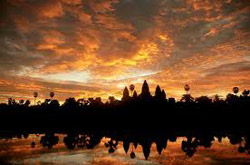 Morning tour:
Morning tour:
Visit Angkor Thom comprised of the Bayon Temple, Baphoun, Elephant Terrace and The Terrace of the Leper King.
Enter Angkor Thom through the monumental south gate, Avenue of gods and asuras lining the bridge across the structure moat.
Bayon temple or state temple of Javavarman 7 is one of the most enigmatic and powerful religious constructions in the world. It is a unique mass of “face tower” which creat a stone mountain of ascending peaks. There were originally 54 towers of which is 37 are still standing today. Most are carved with four faces on each cardinal point. The central has many more.
Baphoun is the vast temple near the center of Angkor Thom. It’s under France’s restoration project, it is possible to access the entrance gate and the elevated walkway entrance and there is a huge reclining Buddha on the west side of the temple.
Elephant Terrace is the heart of Angkor Thom and looks out over the Royal Square. It marks the entrance to the Royal Palace and the focal point for the royal receptions. The carvings of elephants along its wall give its modern name.
Terrace of Leper King This massive terrace is named after the 15th century sculpture that was discovered on top of it. It probably dates back to the reign of Javavarman 7 and has been restored in the manner which allows visitors to explore the earliest to most recent addition by actually entering the internal layers of the structure.
Afternoon tour:
Angkor Wat & Sunset at Bakheng Hill. Built between the 9th and 14th centuries, the temple of Angkor are among the grandest monuments ever constructed. The entire complex covers approximately 164 square miles with over 200 temples. Among the 30 temples that are accessible today, the most famous is Angkor Wat, the largest religious building in the world. Conceived by Suryavarman II in the early 12th century, Angkor Wat took an estimated 37 years to build. Unlike most other Khmer temples, it faces west, the most likely reason being that the temple was dedicated to Vishnu, who is sometimes associated with the west.
Bakheng Hill is for sunset, late 9th century was the state temple of the first capital of Angkor. The view from the top is magnificent, particularly of Angkor wat to the south east and is the most popular spot for visitor at sunset.
Day II
Morning tour:
Depart for jewel of Angkor, Banteay Srei, known as the “citadel of the women” or “Citadel of Beautiful” presumably referring to its size and delicacy of its decoration.
Unlike the major sites of Angkor, Banteay Srei was not a Royal Temple. It was built not by kings, but by King’s guru. Often described in terms as the jewel of Khmer art, Banteay Srei is a temple of great beauty and compares with little else in Angkor. Its miniature scale almost always surprises visitors and the near total decoration of its surfaces is exceptional.
On the way back from Banteay Srei , you will see beautiful brick temple Pre Rup. Brick temples built earlier than Sandstone temple.
Ta Prohm or Tomb Raider Temple was built in 1186, 12th century by Jayavarman VII as a royal monastery. It was dedicated to the King’s mother. This temple was chosen to be left in its natural state as an example of how most of Angkor looked, upon its rediscovery in the 19th century. Shrouded in jungle, the temple of Ta Prohm ethereal in aspect and conjures up a romantic aura with gigantic roots and branches intimately with the stones and probing walls to form a natural roof above the manmade structures.
Afternoon tour:
Floating Village in the Tonle Sap Lake (Great Lake) and Artisan Angkor (fine arts school) and Local market.
End of Services
- Angkor Pass: 62USD per person (pay by your own account)
- Transportation +Tour Guide : 160.00 USD (Max 03 Passangers)
- Mini-van (3-8 pax) + Tour Guide : 190.00 USD
Note: The tour is also included Cool drinking water and towers.
***. Boat Ticket for Floating Village, you pay by your own.
***. Tip: it is not included but it depends on your kindness for guide and driver.
THREE DAYS VISIT
Day I
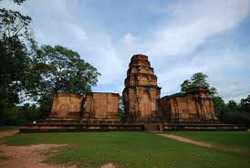 Morning tour
Morning tour
Visit Angkor Thom comprised of the Bayon Temple, Baphoun, Elephant Terrace and Leper King Terrace.
Bayon temple or state temple of Javavarman VII is one of the most enigmatic and powerful religious constructions in the world. It is a unique mass of “face tower” which created a stone mountain of ascending peaks. There were originally 54 towers of which is 37 are still standing today. Most are carved with four faces on each cardinal point. The central has many more.
Baphoun is the vast temple near the center of Angkor Thom. It’s under France’s restoration project, it is possible to access the entrance gate and the elevated walkway entrance and there is a huge reclining Buddha on the west side of the temple.
Elephant Terrace is the heart of Angkor Thom and looks out over the Royal Square. It marks the entrance to the Royal Palace and the focal point for the royal receptions. The carvings of elephants along its wall give its modern name.
Angkor Wat & Sunset at Phnom Bakheng. Built between the 9th and 14th centuries, the temple of Angkor are among the grandest monuments ever constructed. The entire complex covers approximately 164 square miles with over 200 temples. Among the 30 temples that are accessible today, the most famous is Angkor Wat, the largest religious building in the world. Conceived by Suryavarman 2 in the early 12th century, Angkor wat took an estimated 37 years to build. Unlike most other Khmer temples, it faces west , the most likely reason being that the temple was dedicated to Vishnu, who is sometimes associated with the west.
Day II
On the way back from Banteay Srei , you will see beautiful brick temple Pre Rup. Brick temples built earlier than Sandstone temple.
Afternoon tour:
Preah Khan built in the 12th century was one of Javavarman VII ’s largest projects dedicated to his father. Preah Khan was much more than a temple with over 1,000 teachers it appears also to have been a Buddhist university as well as a considerable city. Preah Khan is located on the western edge of its own long Baray, the Jayatakata, and the terraced landing stage at the end of the temples W-E axis access to the lake with a moat surrounding the city.
Afternoon tour:
Floating Village in the Tonle Sap Lake (Great Lake) and Artisan Angkor (fine arts school) and Local market
Note:The tour is also included Cool drinking water and towers.
***. Boat Ticket for Floating Village, you pay by your own.
***. Tip: it is not included but it depends on your kindness for guide and driver.
***. Tip: it it snot included but it depends on your kindness for guide and driver.
End of Services
- Angkor Pass: 62 USD per person (pay by your own account)
- Transportation + Tour Guide : 210.00 USD (Max 03 Passangers)
- Mini-van (4-10 pax) + Tour Guide : 255.00 USD
Find and Book at our low price |









